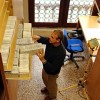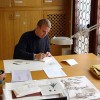This ambitious project of cataloguing the Venice Fungal Collection using DNA information was made possible thanks to a collaborative effort between the Fondazione Musei Civici di Venezia and the Forest Pathology and Mycology Laboratory of the College of Natural Resources at U.C. Berkeley. The project started in April 2006, and collection of DNA sequence data was completed in 2011.
The Natural History Museum of Venice Giancarlo Ligabue hosts the largest and best preserved fungal collection in Italy with more than 25,000 samples, representing approximately 6,000 species of fungi including many rare specimens. The collection is unique as it is entirely generated and curated by volunteers, and in fact it is the outlet of the largest amateur mycological association in the world, the Associazione Micologica Bresadola, which currently has 13,000 active members.
Matteo Garbelotto (UC Berkeley) has worked with Italian mycologist Giovanni Robich and Luca Mizzan, curator of Marine Biology at the Natural History Museum of Venice Giancarlo Ligabue, to sort through the samples in the museum, which were being sent to Garbelotto’s lab at UC Berkeley for DNA sequencing and analysis.
Fungi are a kingdom of organisms that include yeasts, mushrooms and mold. They are essential to most terrestrial ecosystems, channeling nutrients in the soil and making them available for the growth of plants, including trees and agricultural crops. Fungi are microbes that can only be identified when they produce fruiting bodies such as mushrooms; because mushrooms are only produced seasonally and sometimes very rarely, the resulting database will facilitate identification of fungi present in plants, in the soil, and in the air at all times, simply by comparing DNA information with the one generated by this and other studies.
The DNA sequence data generated by this project are now available to the public and research communities and can enhance the ability to identify fungi in the environment. DNA-based identification of fungi in the environment can aid in the diagnosis of plant and animal diseases, enhance studies of fungal diversity and evolution, and lead to a better understanding of factors influencing nutrient cycling and productivity in forests and agricultural ecosystems. Garbelotto comments: “This provides governments with pivotal information needed to avoid repeated introductions of pathogens.”
The following scientific publication describing data collection and analyses has been accepted for publication and is currently in press (available in spring or summer, 2013):
Osmundson T.W., Robert V.A., Schoch C.L., Baker L.J., Smith A., Robich G., Mizzan L., Garbelotto M., 2013. Filling gaps in biodiversity knowledge for macrofungi: contributions and assessment of an herbarium collection DNA barcode sequencing project. In press, PLoS ONE.
Read more: http://www.plosone.org/article/info%3Adoi%2F10.1371%2Fjournal.pone.0062419
Supplemental data from the project are available using the following links:
- List of specimens with full-length, double-stranded ITS sequences analyzed (XLSX 46 KB) >>>
- Sequence data analyzed, grouped by genus (ZIP 107 KB) >
- Please read the important “readme file” first (DOC 25 KB) >
Contact Matteo Garbelotto – matteog@berkeley.edu to request access to additional, mostly single-stranded, sequence data generated during the project.

